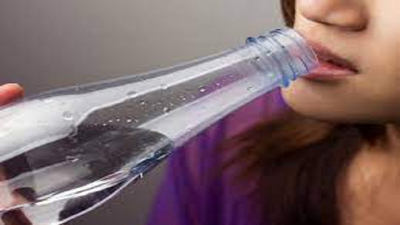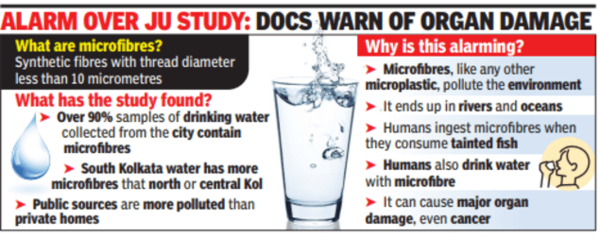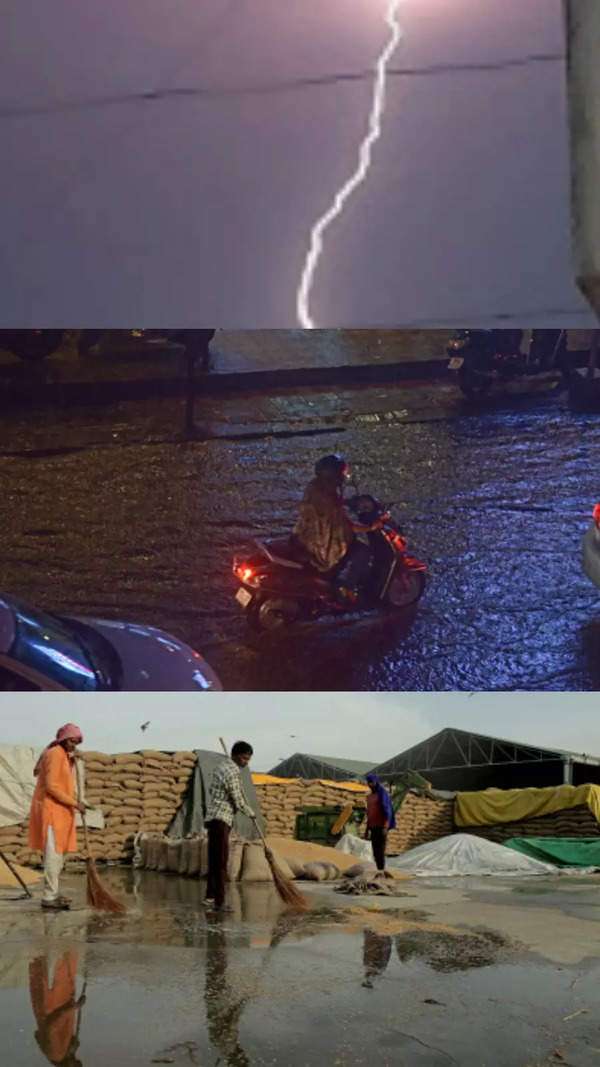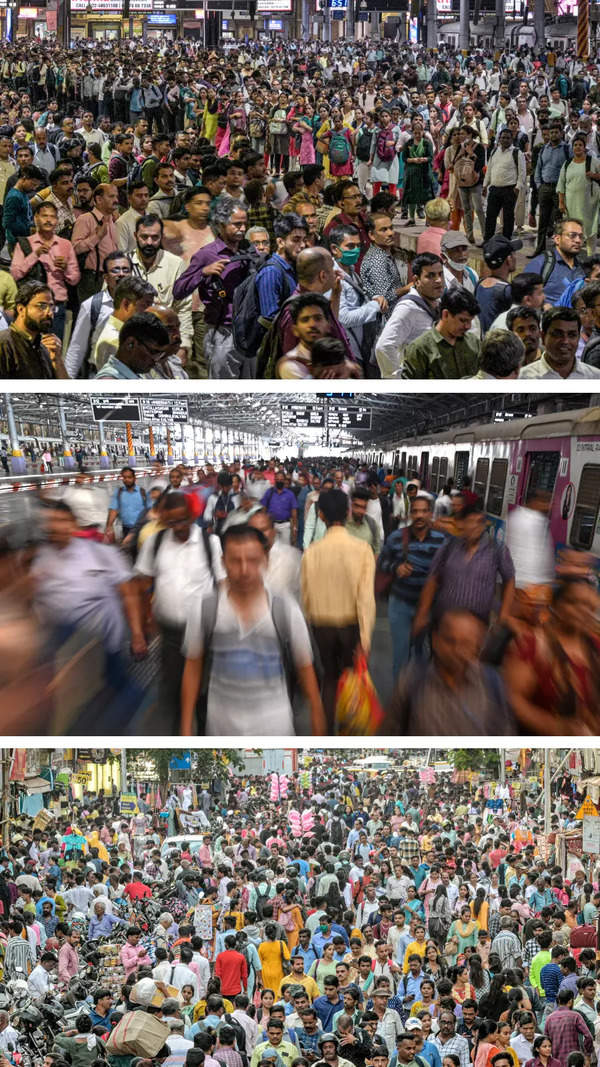- News
- City News
- kolkata News
- Microfibre taint in 90% of Kolkata's drinking water
Trending Topics
Microfibre taint in 90% of Kolkata's drinking water

Image used for representational purpose
KOLKATA: Microfibres - ultra-fine plastics invisible to the naked eye - have been detected in over 90% samples of drinking water collected from various parts of the city, triggering alarm bells on adverse health impact.
Once ingested, this can cause serious, irreversible damage to the heart, lungs and the gastrointestinal system, scientists have warned.

Microfibres are synthetic fibres, with each thread having a diameter of less than ten micrometres. Usually made of polyesters, microfibres are to be found in several commonly used domestic items: mats, apparel, upholstery and cleaning products. One of the biggest source of microfibre pollution is washing machines effluents, which find their way to the river and the sea.
Experts say microfibre pollution is a "silent killer". Apart from affecting aquatic environments, worldwide studies have found the presence of microfibres in blood vessels, urine, breast milk, placental and liver tissues.
The research was carried out by a team from Jadavpur University (JU) between 2018 and 2020. More than 200 samples were collected from around the city. Research scholar Ishita Mondal said the samples were categorised into "private" and "public": samples collected from private residences and hostels were labelled under the former category; the latter category comprised samples from schools, universities, railway stations, Metro stations, clinics, hospitals and offices.
The analysis threw up some trends. For one, more microfibres were found in south Kolkata than in central or north Kolkata. Within same regions in the city, too, the difference in pollution was stark, depending on source. In south Kolkata, the average microfibre count was 1,140 per litre of drinking water collected from public places and 570 from private places. In north Kolkata, the corresponding figures were 1,100 and 540; in central Kolkata, this was 1,016 and 560.
Prasanta Kumar Biswas, a professor in JU's food technology and biochemical engineering department, felt it was "alarming" that over 90% samples contained microfibre. He said "private" samples had less microfibre because of sophisticated water filters.
Microfibres are silent killers: Docs
Debasis Ghosh, a researcher and a visiting faculty to JU's food technology and biochemical engineering department, said: "The ever-increasing population density of south Kolkata can be responsible for higher levels of water pollution caused by microfibres from wash effluents."
Arindam Biswas, a general medicine consultant with R N Tagore Hospital, said microfibres were "silent killers", which could affect the entire body. "When ingested, it can affect the liver, the intestinal absorption process and cause damage to the kidney," he said, adding, "Microfibre particles may also reach the brain and have long-term consequences on its functioning."
Kinsuk Das, a senior gastroenterologist at Apollo, said: "The most common effect is decreased appetite. All phases of food breakdown, digestion and absorption gets affected. This can precipitate oncogenesis (development of cancer) in the long term. Some of these materials are poisonous to the liver cells."
Pritha Bhattacharjee, assistant professor at Calcutta University, said microfibre pollution was an emerging concern. "The textile industry is growing rapidly, with high production of synthetic fibres. Washing a dress material releases plenty of microfibres, which can be soaked with thousands of harmful chemicals and carcinogenic dyes. Despite water treatment, microfibres may be leaked into aquatic systems, rivers or oceans," she said.
Once ingested, this can cause serious, irreversible damage to the heart, lungs and the gastrointestinal system, scientists have warned.

Microfibres are synthetic fibres, with each thread having a diameter of less than ten micrometres. Usually made of polyesters, microfibres are to be found in several commonly used domestic items: mats, apparel, upholstery and cleaning products. One of the biggest source of microfibre pollution is washing machines effluents, which find their way to the river and the sea.
Experts say microfibre pollution is a "silent killer". Apart from affecting aquatic environments, worldwide studies have found the presence of microfibres in blood vessels, urine, breast milk, placental and liver tissues.
The research was carried out by a team from Jadavpur University (JU) between 2018 and 2020. More than 200 samples were collected from around the city. Research scholar Ishita Mondal said the samples were categorised into "private" and "public": samples collected from private residences and hostels were labelled under the former category; the latter category comprised samples from schools, universities, railway stations, Metro stations, clinics, hospitals and offices.
The analysis threw up some trends. For one, more microfibres were found in south Kolkata than in central or north Kolkata. Within same regions in the city, too, the difference in pollution was stark, depending on source. In south Kolkata, the average microfibre count was 1,140 per litre of drinking water collected from public places and 570 from private places. In north Kolkata, the corresponding figures were 1,100 and 540; in central Kolkata, this was 1,016 and 560.
Prasanta Kumar Biswas, a professor in JU's food technology and biochemical engineering department, felt it was "alarming" that over 90% samples contained microfibre. He said "private" samples had less microfibre because of sophisticated water filters.
Microfibres are silent killers: Docs
Debasis Ghosh, a researcher and a visiting faculty to JU's food technology and biochemical engineering department, said: "The ever-increasing population density of south Kolkata can be responsible for higher levels of water pollution caused by microfibres from wash effluents."
Arindam Biswas, a general medicine consultant with R N Tagore Hospital, said microfibres were "silent killers", which could affect the entire body. "When ingested, it can affect the liver, the intestinal absorption process and cause damage to the kidney," he said, adding, "Microfibre particles may also reach the brain and have long-term consequences on its functioning."
Kinsuk Das, a senior gastroenterologist at Apollo, said: "The most common effect is decreased appetite. All phases of food breakdown, digestion and absorption gets affected. This can precipitate oncogenesis (development of cancer) in the long term. Some of these materials are poisonous to the liver cells."
Pritha Bhattacharjee, assistant professor at Calcutta University, said microfibre pollution was an emerging concern. "The textile industry is growing rapidly, with high production of synthetic fibres. Washing a dress material releases plenty of microfibres, which can be soaked with thousands of harmful chemicals and carcinogenic dyes. Despite water treatment, microfibres may be leaked into aquatic systems, rivers or oceans," she said.
Start a Conversation
FOLLOW US ON SOCIAL MEDIA
FacebookTwitterInstagramKOO APPYOUTUBE










